Tim Hortons
Tim Hortons Inc. is a fast food restaurant chain, specializing in coffee, doughnuts, and other fast food items.[5][6] It is Canada's largest quick service restaurant chain; as of December 31, 2018, it had a total of 4,846 restaurants in 14 countries.[4][7][8][9] The company has its headquarters in Toronto.
 | |
Formerly | Tim Horton Donuts Tim Donuts Limited The TDL Group |
|---|---|
| Subsidiary | |
| ISIN | CA88706M1032 |
| Industry | Restaurants[1] |
| Founded | May 17, 1964 Hamilton, Ontario, Canada |
| Founders | |
| Headquarters | Toronto, Ontario, Canada |
Number of locations | 4,846 (December 31, 2018)[3][4] |
Areas served |
|
Key people | Alex Behring (Chairman of Restaurant Brands International) José Cil (CEO of Restaurant Brands International) Alex Macedo (President of Tim Hortons) |
| Parent | Wendy's (1995–2006) Restaurant Brands International (2014–present) |
| Website | TimHortons.com |
The company was founded in 1964 in Hamilton, Ontario, by Canadian hockey player Tim Horton (1930–1974) and Jim Charade (1934–2009), after an initial venture in hamburger restaurants.[10][11] In 1967, Horton partnered with investor Ron Joyce (1930–2019), who assumed control over operations after Horton died in 1974. Joyce expanded the chain into a multi-billion dollar franchise. Charade left the organization in 1966 and briefly returned in 1970 and 1993 through 1996.
On August 26, 2014, Burger King agreed to purchase Tim Hortons for US$11.4 billion;[12] the chain became a subsidiary of the Canadian holding company Restaurant Brands International, which is majority-owned by Brazilian investment firm 3G Capital, on December 15, 2014.[13]
History
1964–1989: Tim Horton and Ron Joyce
.jpg)
The chain's first store opened on May 17, 1964, in Hamilton, Ontario, under the name "Tim Horton Donuts"; the name was later abbreviated to "Tim Horton's" and then changed to "Tim Hortons" without the possessive apostrophe. The business was founded by Tim Horton, who played in the National Hockey League, from 1949 until his death in an auto crash in 1974.[14][15] Horton had an initial venture in hamburger restaurants.[10]
Soon after Horton opened the store, he met Ron Joyce, a former Hamilton police constable. In 1965, Joyce took over the fledgling Tim Horton Donut Shop at 70 Ottawa St N. By 1967, after opening two additional stores, Joyce and Horton became full partners. Upon Horton's death, in an automobile crash in 1974, Joyce bought out the Horton family's shares for $1 million and took over as sole owner of the existing chain of 40 stores, quickly and aggressively expanding the chain in both geography and product selection. The 500th store opened in 1991.[16]
Ron Joyce's aggressive expansion of the Tim Hortons business resulted in major changes to the Canadian coffee and doughnut restaurant market. Many independent doughnut shops and small chains were driven out of business, while Canada's per-capita ratio of doughnut shops surpassed that of all other countries.[17]
The Horton and Joyce partnership carried on, with the marriage of Joyce's son, Ron Joyce Jr., and Horton's eldest daughter, Jeri-Lynn Horton-Joyce, who are joint owners of Tim Hortons franchises in Cobourg, Ontario.[18]
1990–2002: Name change and growth
.svg.png)
The company had originally been incorporated as Tim Donut Limited.[11] By the 1990s, the company name had changed to The TDL Group Ltd. This was an effort by the company to diversify the business, removing the primary emphasis on doughnuts, and continuing the expansion of the menu options as consumer tastes broadened.[16]
Some older locations retain signage with the company's name including a possessive apostrophe, despite the fact that the official styling of the company's name has been Tim Hortons, without an apostrophe, for at least a decade.[19] The company had removed the apostrophe after signs using the apostrophe was interpreted by some to be breaking the language sign laws of the Province of Quebec in 1993.[20] The removal of the apostrophe allowed the company to have one common sign image across Canada.[21]
Although a number of Quebec locations have bilingual menu boards, the decision to have both Canadian official languages represented is left to the discretion of individual franchise owners. Some Quebec locations have French-only menu boards. It is the strong recommendation to all the Quebec restaurants from the TDL Group Corporation that they post menu boards in both English and French in accordance with the standards being enforced by the Office québécois de la langue française.[22]
Merger with Wendy's
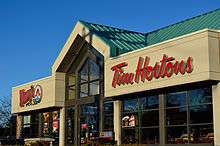
In 1992, the owner of all Tim Hortons and Wendy's Restaurants in Prince Edward Island, Daniel P. Murphy, decided to open new franchise outlets for both brands in the same building in the town of Montague. Murphy invited Joyce and Wendy's chairman Dave Thomas to the grand opening of the "combo store", where the two executives met for the first time. Murphy's success with combining coffee and doughnuts with Wendy's fast food led to the August 8, 1995, acquisition of and merger with TDL Group by Wendy's International, Inc., an American company.[23] Joyce became the largest shareholder in Wendy's, even surpassing Thomas. TDL Group continued to operate as a separate subsidiary from its head office in Oakville, Ontario, although Joyce eventually retired from active management to pursue other interests.
The sale was widely commented on in the media. In 1995, the Toronto Star had a column reflecting on Tim Hortons "selling out" to Wendy's with "the spectacle of another great Canadian icon... gone to Yankee burgerfat".[24]
2002–2006: Regaining independence
Tim Hortons franchises spread rapidly and eventually overtook McDonald's as Canada's largest food service operator. The company opened twice as many Canadian outlets as McDonald's by 2005,[25] and system-wide sales also surpassed those of McDonald's Canadian operations as of 2002.[26] The chain accounted for 22.6% of all fast food industry revenues in Canada in 2005.[25]
Under pressure from major investors Peter May and Nelson Peltz,[27] in late 2005, Wendy's announced it would sell between 15% and 18% of the Tim Hortons operations in an initial public offering, which was completed on March 24, 2006, and subsequently said it would spin-off to shareholders its remaining interest by the end of 2006.[28] Wendy's cited increased competition between the two chains and Tim Hortons' increasing self-sufficiency as reasons for its decision, but the company had been under shareholder pressure to make such a move because of the strength and profitability of the Tim Hortons brand.[29] Peltz in 2008 acquired Wendy's after pressuring them initially to spin off Tim Hortons.
Shares of the company began trading on March 24, 2006, with an initial public offering of C$27 per share, raising over $700 million in the first day of trading. On September 24, 2006, Wendy's spun off the rest of its shares in Tim Hortons, by distributing the remaining 82% to its shareholders.[30] On the same day, Tim Hortons was added to Canada's benchmark stock-market indicator, the S&P/TSX Composite Index, and to the S&P/TSX 60.[31] Despite maintaining its operational headquarters in Oakville, the spun-off holding company, Tim Hortons Inc., was initially incorporated in Delaware.
As of March 2006, Tim Hortons commanded 76% of the Canadian market for baked goods (based on the number of customers served) and held 62% of the Canadian coffee market (compared to Starbucks, in the number two position, at 7%).[32]
2007–2013: Repatriation
On June 29, 2009, Tim Hortons Inc. announced that, pending shareholder approval, the chain's operations would be reorganized under a new publicly traded company, also named "Tim Hortons Incorporated," incorporated under the Canada Business Corporations Act. The change was being made primarily for tax purposes.[33][34] On September 28, 2009, Tim Hortons Inc. announced it had completed the reorganization of its corporate structure to become a Canadian public company.[35][36]
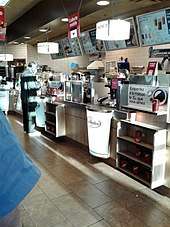
In November 2010, Tim Hortons extended Interac debit payment system acceptance to most of its stores. The company previously began accepting Interac in its stores in Western Canada in 2003 and, later, MasterCard and MasterCard PayPass across most of its stores in 2007. The company often indicated the delay of broader or wider electronic payment acceptance was to "ensure speed of service."[37][38] In 2012, Tim Hortons began accepting Visa cards, and in 2013, began accepting American Express cards.[39][40]
As of late 2013, Tim Hortons had "4,350 cafes across the world, out of which 3,500 are in Canada, 817 in the US and 33 in the GCC. The Toronto Stock Exchange listed company recorded revenues of $794 million and net profit of $111 million in the September quarter."[41]
2014: Merger with Burger King
On August 24, 2014, US fast-food chain Burger King announced that it was in negotiations to merge with Tim Hortons Inc;[42] the proposed $18 billion mergers would involve a tax inversion into Canada, with a new holding company majority-owned by 3G Capital, and the remaining shares in the company held by current Burger King and Tim Hortons shareholders. A Tim Hortons representative stated that the proposed merger would allow Tim Hortons to leverage Burger King's resources for international growth; the two chains would retain separate operations post-merger.[43] News of the proposal caused Tim Hortons' shares to increase in value by 28 percent.[44]
On August 25, 2014, Burger King officially confirmed its intent to acquire Tim Hortons Inc. in a deal totaling CDN$12.5 billion (US$11.4 billion).[45] 3G Capital offered to purchase the company at $65.50 per share, with existing shareholders receiving $65.50 in cash and 0.8025 shares in the new holding company: per-share—all-cash ($88.50) and all-shares (3.0879) options were also made available. The agreement planned to result in 3G Capital (which held a 71% majority stake in Burger King) holding a 51% majority stake in the new company, Tim Hortons' existing shareholders owning 22%, and Burger King's owning 27% with the new entity based in Oakville and listed on both the TSX and New York Stock Exchange. Per the agreement, Burger King CEO Daniel Schwartz became CEO of the company, with existing Tim Hortons CEO Marc Caira becoming vice-chairman and director; Burger King itself still operated out of its existing headquarters in Miami. It was announced the deal would form the third-largest fast-food restaurant company in the world.[44] On October 28, 2014, the deal was approved by the Competition Bureau of Canada,[46] but had yet to be approved by Industry Canada. The Bureau ruled that the deal was "unlikely to result in a substantial lessening or prevention of competition."[47]
Former CEO Marc Caira reassured the integrity of Tim Hortons following the purchase, stating that the acquisition would "enable us to move more quickly and efficiently to bring Tim Hortons iconic Canadian brand to a new global customer base."[44][48] On October 30, 2014, various media covered a Canadian Centre for Policy Alternatives study which suggested that Burger King's proposed takeover of Tim Hortons is "likely to have overwhelmingly negative consequences for Canadians."[49][50] This study analysed Burger King's private equity owner, 3G Capital, past takeovers of Burger King, Heinz, and Anheuser-Busch and declared that "it has a 30-year history of aggressive cost cutting, which could hurt Tim Hortons employees, small-businesspeople, Canadian taxpayers, and consumers."[49][51]
The deal was approved by Minister of Industry James Moore (of the governing Conservative Party of Canada) on December 4, 2014: The two companies agreed to Moore's conditions, requiring that the Burger King and Tim Hortons chains retain separate operations and not combine locations, maintain "significant employment levels" at the Oakville headquarters, and ensure that Canadians make up at least 30% of Tim Hortons' board of directors.[52] Tim Hortons shareholders approved the merger on December 9, 2014; the two chains merged under the new parent company Restaurant Brands International (RBI), which began trading on December 15, 2014.[53][54][55] According to CBC News, "how the government will enforce [Moore's] conditions is unclear."[56]
2015–present: Recent years
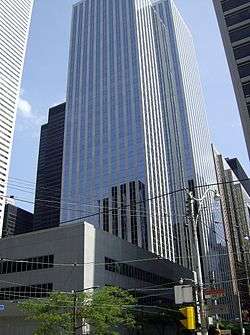
In May 2015, the company announced the closure of its U.S. headquarters in Dublin, Ohio; in March 2015, it had 127 employees. This headquarters was a relic of the former merger with Wendy's, which is also based in Dublin. In August 2016, Tim Hortons again changed presidents.[57] In September 2016, Tim Hortons announced it would be expanding into the United Kingdom, with an unannounced number of locations to be built.[58]
Revenue in 2015 for RBI was US$4.0522 billion[59] with a rise to $4.15 billion in 2016.[60] Tim Hortons had 683 U.S. locations by the end of 2016, and total annual revenue of US$3.00 billion.[61]
In April 2018, Tim Hortons announced that they would be moving their head office along with its 400 employees to the Exchange Tower in Downtown Toronto.[62]
In May 2018, the Reputation Institute reported that Tim Hortons had fallen from 13th to 67th in its study of Canada's most reputable companies, as "one of the largest moves down of all 250 companies it analyzed this year'" and that the brand was "still considered to have a 'strong reputation.'"[63]
Beginning in October 2018, Tim Hortons began to install self-serve kiosks at some locations in Ontario.[64] In February 2019, Tim Hortons began to spread the installation of the self-serve kiosks across Canada.[64]
Locations
As of June 30, 2013, Tim Hortons has 4,304 restaurants, including 3,802 in Canada,[65] 807 in the United States, 29 in the Middle East,[66] and 25 in the UK.[67]
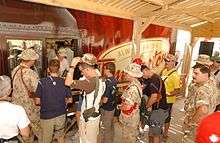
Tim Hortons' has a presence on a number of military bases, including Kandahar, Afghanistan,[68][69][70] although this latter outlet was principally intended for Canadian Armed Forces and allied military personnel. Three more outlets are located in military bases at Aberdeen Proving Ground, Maryland,[71] Fort Knox, Kentucky,[72] and Naval Station Norfolk, Virginia.[73]
North America
Tim Hortons was originally concentrated in Ontario and Atlantic Canada. In recent years, however, the chain has greatly expanded its presence into Quebec and western Canada.[74] Its location in Iqaluit, Nunavut, is the northernmost store as of 2010.[75]
TDL Group recorded $1.48 billion in sales in 2005.[76] Tim Hortons also operates locations on US and Canadian university campuses, including Durham College, Georgian College, Canisius College, York University, Ryerson University, University of Buffalo, SUNY Fredonia,[77]SUNY Plattsburgh,[78] UBC, Memorial University, and Simon Fraser University.[79]
In March 2010, Tim Hortons announced further expansion on both sides of the Canada–US border to be completed by 2013. The plan calls for 600 new stores in Canada (primarily in Quebec and Western Canada but also including smaller communities) and 300 new stores in the US (primarily in its existing markets of Michigan, New York, and Ohio). It also calls for expansion into such non-standard store locations as hospitals, universities, and airports, as well as extending its co-branding initiative with US ice cream chain Cold Stone Creamery, which began in 2009, to cover 60 Canadian stores and 25–35 new and existing US stores. It will also include testing a new café/bake shop concept in at least 10 existing US locations, including "enhanced finishes, fixtures, and seating areas" as well as an expansion of menu offerings.[80][81]
In 2010, Tim Hortons opened its northernmost locations in the world: three kiosks at NorthMart stores in Iqaluit, Nunavut. This expanded Tim Horton's presence in every province and territory of Canada. According to Nick Javor, senior vice-president of corporate affairs at Tim Hortons, "You could say it's overdue. If we can be in Kandahar, why can't we be in Iqaluit?"[83] In December 2011, Tim Hortons opened its 4000th restaurant.[84] In 2012, Tim Hortons Inc. recorded its total revenues at $3.12 billion (CDN).[84] As of 2012 the company had expanded across Canada.[84]
United States
Initially, the US stores were the result of natural expansion in Canada–U.S. border areas (e.g., stores in Maine and the Buffalo, New York, area where Horton played from 1972 to 1974 as a member of the Buffalo Sabres). The first United States locations were opened in Deerfield Beach, Florida, and Pompano Beach, Florida, in 1981, but they proved unsuccessful and were closed.[85]
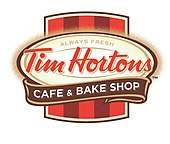
In 1985, the chain returned to the US with a location on Niagara Falls Boulevard in the Buffalo suburb of Tonawanda, New York.[86] Starting in the mid-1990s, however, the chain began expanding in the US by acquiring former locations from fast-food chains. In 1996 and 1997, thirty-seven former Rax Restaurants locations in Ohio, Kentucky, and West Virginia were bought by Wendy's International Inc.; 30 of these were converted to Tim Hortons, while the others became Wendy's franchise locations. Thirty-five closed Hardee's stores in the Detroit area were also purchased with the intention of being converted.[87] By 2004, the chain had also acquired 42 Bess Eaton coffee and doughnut restaurants situated in southern New England. Several combination Wendy's/Tim Hortons units were opened in the US; both in the "traditional" markets of Maine and Buffalo, where there were well over 180 locations as of 2011,[88] and in the markets entered through acquisition.
In October 2008, Tim Hortons announced a plan to add 82 locations in Tops Markets stores in the United States.[89]
On July 13, 2009, Tim Hortons opened stores in New York City at former Dunkin' Donuts locations operated by the Riese Organization. One of the stores is located at Madison Square Garden, where Horton played as a member of the New York Rangers from 1969 to 1971.[90] In 2009, Tim Hortons opened its first store in Albany, NY, with more stores on the way. Tim Hortons continued its southward expansion in the US by opening a restaurant at Naval Station Norfolk, Norfolk, Virginia, in mid-December 2009. In November 2010, Tim Hortons announced it was closing 36 stores in the northeastern United States due to high competition with New England-based Dunkin' Donuts and Au Bon Pain. The stores, which made less than half the average company per-store sales, were concentrated heavily in the Providence, Rhode Island, and Hartford, Connecticut, areas, the former of which also has a concentration of stores from the locally-competing Honey Dew Donuts chain, itself with some 150 outlets in Rhode Island and Southeastern Massachusetts. In the announcement, the chain stated that it will concentrate its efforts on its core markets such as western Canada. In the same statement, the company announced the sale of its portion of distribution company Maidstone Bakeries to Tim Hortons' European partners. It will use the C$400 million generated by the sale for a stock buyback.[91]
.jpg)
In 2010, Tim Hortons opened two kiosks at Consol Energy Center (now known as PPG Paints Arena) in Pittsburgh, partly as a test to eventual expansion into Pittsburgh (their closest locations at that point were in the Wheeling, West Virginia/Steubenville, Ohio area) as well as Pittsburgh Penguins star Sidney Crosby having a longtime sponsorship with the chain as well. In addition, Horton played for the Maple Leafs American Hockey League affiliate, the Pittsburgh Hornets, earlier in his career as well as the Penguins for one season in 1971–72.[92] Aramark, which operated the kiosks, closed them in 2012, however Tim Hortons proceeded to open full-service locations in Pittsburgh and surrounding areas in July 2012. At the time of the entry into Pittsburgh, of the four NHL cities Horton played in (Buffalo, New York City, Toronto, and Pittsburgh), Pittsburgh was the only one without a Tim Hortons location, and was also where Horton met his future wife, Lori.
2011 saw Tim Hortons aggressively expanding into the Grand Rapids, Michigan, region.[93]
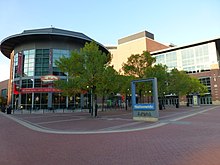
In 2012, Tim Hortons began advertising in the Youngstown, Ohio area in anticipation of an eventual expansion into the Mahoning Valley. The closest location at the time was in Calcutta, Ohio, about 50 miles south of Youngstown. The chain entered the area in July 2012 with the opening of a location in Hermitage, Pennsylvania.[94] This location has since closed, but Tim Hortons would return to the market in the spring of 2019 with the opening of two locations, one in Youngstown and one in Girard,[95] though both would suddenly close within weeks of each other by the end of the year.[96]
As of 2012 the company had expanded across the US states of Connecticut, Indiana, Kentucky, Maine, Massachusetts, Michigan, New York, Ohio, Pennsylvania, Rhode Island, and West Virginia.[84] The first expansion into Indiana was the opening of a location in Richmond, Indiana's east-central side.
On January 7, 2014, Tim Hortons opened a kiosk in the Gila River Arena (where the Arizona Coyotes of the NHL play) in Glendale, Arizona.[97] On March 5, 2014, The Arizona Coyotes announced that as of March 10, 2014, the Tim Hortons stand would be open to the public from 9:00 to 15:00, seven days a week.[98] This location is the first Tim Hortons in Arizona.[99] A flagship Tim Hortons location within the Buffalo area opened across from the KeyBank Center (then First Niagara Center) at the LECOM Harborcenter complex on October 29, 2014.[100] The location honours the life and legacy of Tim Horton. 2014 also saw expansion into North Dakota, with franchises open in Fargo, Grand Forks, and Minot.
The chain also planned to open 40 outlets in the St. Louis, Missouri, area starting in 2015, first selling coffee and hot chocolate at Enterprise Center during St. Louis Blues games, followed by the opening of a full-service store in the suburb of Maplewood and an "express" location inside a Frontenac bank building. However, all of the chain's locations in the St. Louis area have now closed. In 2016, Tim Hortons expanded to Minnesota with a store inside Mall of America. However, this location is now closed.[101] In 2017, the chain announced an expansion to Northeast Ohio with 105 stores to come to the greater Cleveland area.[102] The first of these opened in the Ellet neighborhood of Akron in July 2019.[103]
Asia
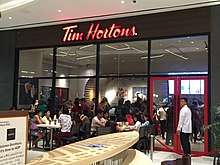
Tim Hortons reportedly had plans by 2013 to enter the large Indian market, which the company denied.[41] In an effort to expand the company following its 2014 merger with Burger King into Restaurant Brands International, Tim Hortons began expansion in Asia in 2017 citing the increasing demand for coffee and large populations.[104][105] The first Southeast Asian branch was opened in the Philippines on February 28, 2017 at Uptown Mall in Bonifacio Global City, Taguig. Miss Universe Canada 2016, Siera Bearchell, was present for the ribbon-cutting ceremony.[106] As of February 2018 there were 11 branches operating in the Philippines plus 24 more branches opening soon, (23 in Metro Manila and one in Pampanga Province).[107]
Through franchise partnership with Dubai based Apparel Group, Tim Hortons entered the United Arab Emirates in 2011 with store openings in Abu Dhabi, Dubai and Fujairah, with the first location opening in September 2011.[108] As of December 2013 it has 19 stores in the United Arab Emirates, two in Oman and two in Saudi Arabia. They plan to open up to 120 stores over the next five years in the Persian Gulf area, with a focus on Qatar, Bahrain, Kuwait, Oman, and the United Arab Emirates.[109][110] Kuwait has Tim Hortons at The Gate Mall in Egaila; at Promenade Mall in Hawalli; at The Avenues Mall at Al Rai.[111]
In July 2018, Tim Hortons announced that they will open 1500 stores in China.[112] The first Tim Hortons store opened at Feb 26, 2019 in Huangpu District, Shanghai.
Tim Hortons In Thailand, The first Tim Hortons store opened at January 18, 2020 at Samyan Mitrtown Mall in Bangkok Through franchise partnership with Thailand based WeEat Co.[113] As of June 2020 there were 5 branches operating in Thailand.
Europe
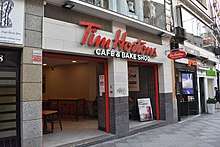
Tim Hortons' products have been available in Ireland and the United Kingdom at some Spar convenience stores since 2006[114] and Tesco supermarkets.[115] Tim Hortons' other international expansions include a small outlet at the Dublin Zoo. Tim Hortons coffee and doughnuts were being sold at small self-service counters in 50 Spar stores in the UK and Ireland as of April 30, 2007.[116]
In 2016, Tim Hortons announced that they would be opening stores in the United Kingdom starting in 2017. Glasgow saw the first UK store open its doors on June 2, 2017, with a further store opening in Bishopbriggs in November 2017. In November 2017, two stores in Cardiff opened. as well as a store opening in Dunfermline. In December 2017, two further stores were opened in Trafford in the towns of Sale and Altrincham. On December 20, 2017, the chain opened a store in the Golden Square Shopping Centre in Warrington. Tim Hortons opened its first 2 stores in Northern Ireland in 2018. One on Fountain Street in Belfast city centre, and another drive-thru store at the Connswater Retail Park in East Belfast. As of August 2019, Tim Hortons has 23 locations in the United Kingdom.[117]
In December 2017, Tim Hortons opened two stores in the centre of Madrid and later opened another in the city of Pozuelo de Alarcón, in the Community of Madrid. The menu also includes typical Mediterranean drinks apart from the typical drinks of a Tim Hortons.[118]
Store growth
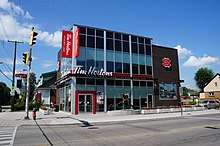
| Store # | Location | Date | Note |
|---|---|---|---|
| 1 | Hamilton, Ontario | May 1964 | |
| 100 | Thunder Bay, Ontario | December 1978 | |
| 200 | Hamilton, Ontario | December 1984 | |
| 300 | Calgary, Alberta | February 1987 | |
| 400 | Halifax, Nova Scotia | February 1989 | |
| 500 | Aylmer, Quebec | January 1991 | |
| 700 | Moncton, New Brunswick | October 1993 | |
| 1000 | Ancaster, Ontario | August 1995 | |
| 1500 | Pickerington, Ohio | March 1997 | also Wendy's 5,000th store |
| 100 in the United States | Columbus, Ohio | July 31, 1998 | |
| 2000 | Toronto, Ontario | December 2000 | |
| 2500 | Cayuga, Ontario | September 2003 | |
| 3000 | Orchard Park, New York | December 14, 2006 | [10] |
| 500 in the United States | Detroit, Michigan | 2008 | |
| 4 in Kuwait | Kuwait | 2013 | |
| 1 in Oman | Oman | 2012 | |
| 2 in the Philippines | Manila, Philippines | February 28, 2017 | |
| 20 in the United Kingdom | United Kingdom | December 2018 | |
| 19 in the United Arab Emirates | Dubai, United Arab Emirates | September 20, 2011 | |
| 31 in Saudi Arabia | Saudi Arabia | 2016 | |
| 3 in Qatar | Doha, Qatar | May 2013 | |
| 2 in Spain | Madrid, Spain | December 2017 | |
| 3 in Mexico | Monterrey, Mexico | January 2018 | |
| 5 in Thailand | Bangkok, Thailand | January 18, 2020 | |
| 3 in China | Shanghai, China | February 26, 2019 |
Menu
Tim Hortons' first stores offered only two products – coffee and doughnuts.[10] Aside from its coffee, tea, hot chocolate, and doughnuts, the menu now contains a number of other baked goods, such as bagels – of which the brand sells one out of every two in the Canadian food service industry.[120] Nutritional information on most menu items is made available by the company in a two-page brochure and online. The brochure does not list ingredient information.[121] Most of the time Tim Hortons' menu contains many of the same items across different locations. However, the pricing may vary since it is a franchise so the cost of each item may be slightly different depending on the owner of the location.
Coffee and beverages
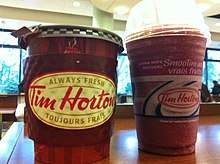
Tim Hortons' sells coffee, tea, hot chocolate,[120] and soft drinks. In the mid-1990s the chain moved into specialty and premium items such as flavored cappuccino, iced cappuccino, and iced coffee.[122]
Originally featuring Pepsi products via fountain machines, the retailer changed in the mid-1990s to Coca-Cola products. For a time they offered bottled and canned Coca-Cola products, but switched back to bottled and canned Pepsi products in 2007. PepsiCo replaced the Coca-Cola products on United States restaurants in 2011, disappointing similar longtime PepsiCo rival Dunkin' Donuts. Dunkin' Donuts moved to Coca-Cola products only for United States restaurants in April 2012 because of this.
Despite an expansion in their food offerings around 2009, the brand remained heavily dependent on coffee sales.[123] In 2009, it was reported that 60% of their sales occur in the morning, and of that more than 50% is coffee.[123] The coffee served is a blend of 100% arabica beans. The "original blend" is a medium, balanced roast that is the most popular served coffee in Canada.[124] The chain has an "always fresh" policy where coffee is served within 20 minutes of brewing.[74]
In November 2011, the company announced that they would be adding espresso machines in 1,000 of their locations, later that month.[125] Lattes were added to Ontario stores on November 14, 2011. In February 2012, they offered a new beverage, White Hot Chocolate, in select branches. On April 16, 2012, the brand launched frozen lemonade, in two flavours: original and raspberry.[126] In May 2014, they first offered frozen green tea. On August 15, 2014, the company added a dark roast coffee blend as an alternative.[127] In the summer of 2015, they introduced a frozen drink called Creamy Chocolate Chill which was essentially a chocolate milkshake topped with chocolate whipped cream and drizzled with chocolate syrup. In addition to the Creamy Chocolate Chill, they also launched a Maple Chill, a maple milkshake topped with regular whipped cream and sprinkled with maple flakes.
Food items
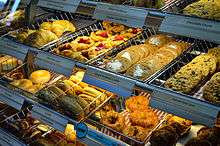
The menu contains a number of other baked goods, such as doughnut holes (branded as Timbits), muffins, croissants, tea biscuits, cookies, rolls, danishes, and bagels.[120] Take-home cakes are offered in some locations. The dutchie is a Canadian doughnut popularized by the Tim Hortons chain.[128]
Since the mid-1990s, the chain has moved into other areas beyond doughnuts and coffee, including specialty and premium items such as New York-style cheesecake, and a lunch selection that includes soups, chili, and submarine-style sandwiches. In the fall of 2006, the chain began rolling out a breakfast sandwich. The sandwich consists of an egg patty, processed cheese slice, and either ham, bacon, or sausage as the topper, and is placed on either a biscuit, English muffin, or bagel.[122] In October 2007, they launched a chicken fajita wrap, which contained spiced chicken and sautéed vegetables. This was discontinued and replaced a year later with the barbecue and ranch chicken wrap snackers. In December 2007, they introduced hash browns and the "Bagel B.E.L.T.", a breakfast sandwich of bacon, egg, lettuce, and tomato on a bagel.[129] In February 2009, they announced co-branding with American ice cream parlor Cold Stone Creamery. The deal called for each chain to convert 50 stores into dual-operation franchises, for a total of 100 stores. The idea was successfully tested at two stores in Rhode Island.[130][131][132][133] Despite this expansion, the brand remained heavily dependent on coffee sales.[123] In February 2014, Tim Hortons announced that the dutchie timbit was discontinued due to low popularity.[134]
Despite the chain's ubiquity across Canada, Tim Hortons has never offered poutine as a regular menu item, despite the fact that poutine (largely seen as Canada's signature dish)[135] is offered at just about every other major restaurant chain in Canada. Tim Hortons did offer poutine for the first time in 2018 across Canada for a limited time, using seasoned potato wedges instead of the typical french fries. Tim Hortons poutine received a mixed social media response.[136][137]
In Canada, the company began to offer hamburgers on the lunch menu in 2017. In an attempt to lure customers with a more healthy option, Tim Horton's offered a hamburger filled with the "Beyond Meat" meatless option. The offering of hamburgers was risky for the company in their attempt to compete with the popular, large hamburger chains such as McDonald's. Wendy's and Burger King in Canada. Ironically, Burger King had acquired Tim Hortons in 2014 and was running it as a separate subsidiary, and had supply chain mechanisms already in place to supply Tim Hortons with hamburger items. However after only a brief period, consumers did not respond well to Tim Horton's offering of hamburgers or the "Beyond Meat" variety. With poor national sales, subsequently in 2019, hamburgers were removed from the menus at the Canadian Tim Hortons stores.
Baking methods and lawsuit
Coupled with the expansion and the expanded menu came the outsourcing of baked goods. Doughnuts, which used to be made at night to be ready for the morning rush, are now parbaked – partly cooked and then frozen and delivered to every restaurant in Canada from Brantford, Ontario.[74] Each restaurant bakes and finishes the product throughout the day. As of April 2007, many of the various muffin batters were being revoked, as frozen, pre-made and pre-wrapped muffins were being introduced at Tim Hortons locations.[138]
Tim Hortons' switch to the parbaking system disappointed some customers, who noted that it contradicts the chain's "always fresh" slogan. David Swick reported in the Halifax Daily News on September 19, 2003, Tim Hortons outlets in Atlantic Canada would no longer serve fresh doughnuts, but rather doughnuts that had been remotely factory-fried and then frozen and shipped.[139] In 2008, two franchisees initiated a class-action lawsuit against the parent company for the switch to parbaking, "claiming breach of contract, breach of duty of fair dealing, negligent misrepresentation, and unjust enrichment".[140] The lawsuit cited that parbaking tripled the franchisee's fixed cost to produce a doughnut (from 6 cents per doughnut to 18 cents),[141] required the purchase of new freezers and microwaves, and reduced profitability for the franchises while increasing profits for the parent company.[140] Franchise owners are required to purchase food products from the Brantford-based parbaking company owned by IAWS Group PLC,[141] and had originally been told the price of each doughnut would be 11 or 12 cents (and each Timbit 4.6 cents).[142] The case was dismissed in February 2012.[143]
A 2009 New York Times article contrasted the baked from scratch at stores' approach of Krispy Kreme and some Dunkin' Donuts locations compared to the "flash frozen" and shipped Tim Hortons method. The Times article also noted an apparent scarcity of doughnut specialties such as the dutchie at newly opened Tim Hortons stores in New York City. Noting that "American visitors tend to flock to the sweets," including the "raisin-studded Dutchie", the Times found redemption among Canadians that the brand was once again a Canada-based company while contrasting the way politicians in the US "woo" soccer moms while in Canada they "go after Tim Hortons voters".[144]
Marketing
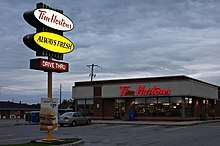
Tim Hortons' advertising slogans have included "You've Always Got Time for Tim Hortons" and starting in the mid-2000s, "Always Fresh. Always Tim Hortons." While both of these slogans are still used, Tim Hortons began using an alternative slogan, "It's Time for Tims" in November 2011.
Canadian Business magazine named Tim Hortons as the best-managed brand in Canada in 2004 and 2005.[145][146][147][148]
Since 2005, Tim Hortons has been the title sponsor of the Brier, the annual Canadian men's curling championships, along with the Canadian Ringette Championships.[149] Resultant sponsored events include the Tim Hortons Brier Shot of the Week Award, 2013 Tim Hortons Brier, 2016 Tim Hortons Brier, and the 2014 Tim Hortons Brier among other years.
Shortly before December 2007, they discontinued their gift certificates and replaced them with the Quickpay Tim Card,[150] with the Christmas slogan "Because it's hard to wrap a double-double" (coffee with two sugars and two creams). Many locations still accept gift certificates, however.
In September 2006, Tim Hortons courted controversy by mandating that employees were not to wear red as part of the Red Fridays campaign by families of the military to show support for Canadian troops. Within a few hours, Tim Hortons partially reversed its position and has allowed staff in Ontario stores to wear red ribbons or pins to show support for the wear red on Fridays campaign.[151]
In June 2009, Tim Hortons USA created Twitter and Facebook pages to drive online traffic.[152][153] After Tim Hortons had agreed to provide 250 cups of free coffee in 2009 for a "Marriage and Family Day" hosted by the National Organization for Marriage, the company removed its sponsorship after it was revealed that the NOM was an organization that campaigns against gay marriage.[154] The company stated the sponsorship was a violation of the company's policy not to sponsor events "representing religious groups, political affiliates or lobby groups."[154][155][156]
On July 12, 2013, it was announced that Tim Hortons had acquired the naming rights to the new stadium being built in Hamilton, Ontario. The new stadium took on the name of Tim Hortons Field. It became the home stadium of the Hamilton Tiger-Cats in 2014.[157] The corporate-sponsored stadium name was not used during the 2015 Pan American Games, when the stadium hosted soccer matches.
In June 2015, Tim Hortons pulled a four-week advertising campaign by energy company Enbridge from its in-store "Tims TV" service after three weeks following a petition by the advocacy group, SumOfUs. Even though the ads were part of a general "Life Takes Energy" campaign introduced by Enbridge the previous year, the group argued that Tim Hortons' airing of the ads implied an endorsement of controversial projects under development by Enbridge, such as the Northern Gateway pipeline, going on to say that "Enbridge's ad campaign uses attractive actors, cute kids and high production values to hide the real truth—its tar sands project will put ecosystems, salmon and wildlife in danger, create virtually no local jobs, and accelerate climate change." The decision to pull the ads, however, resulted in a boycott of Tim Hortons led by Wildrose Party leader Brian Jean, who felt that the decision was an attack on Alberta's oil industry, as Enbridge is one of the province's top-employing companies.[158][159][160][161]
Canadian cultural fixture
.jpg)
Tim Hortons is popularly known as "Timmies".[162] The ubiquity of Tim Hortons, through the wide expansion of its outlets, makes it a prominent feature of Canadian life; Canadians eat more doughnuts per capita and have more doughnut outlets per capita than any other nation.[163][164] Tim Hortons' prevalence in the coffee and doughnut market has led to its branding as a Canadian cultural icon. The media routinely refer to its iconic status, despite this being a relatively recent development; there were only a few outlets before the chain's expansion in the late 1990s and 2000s.[146][147][165][166][167][168] A series of Tim's television commercials promotes this idea by showing vignettes of Canadians abroad and their homesickness for Tim Hortons. Canadian author Pierre Berton once wrote: "In so many ways the story of Tim Hortons is the essential Canadian story. It is a story of success and tragedy, of big dreams and small towns, of old-fashioned values and tough-fisted business, of hard work and of hockey."[146]
Some commentators have bemoaned the rise of Tim Hortons as a national symbol. Rudyard Griffiths, director of The Dominion Institute, wrote in the Toronto Star in July 2006 that the ascension of the chain to the status of a cultural icon was a "worrying sign" for Canadian nationalism, adding, "Surely Canada can come up with a better moniker than the Timbit Nation."[169]
The recognition of Tim Hortons as a Canadian icon has permeated into American culture as the result of product placement efforts in conjunction with a marketing agency.[170] In the American situation comedy How I Met Your Mother, while standing in a Tim Hortons "just around the corner from the Hockey Hall of Fame", Robin, played by Canadian actress Cobie Smulders, called the location the "most Canadian place in the universe". The chain has since embraced that comment as an unofficial slogan and has used it in promotional advertisements to emphasize their fixture in modern Canadian culture. The chain has also been featured in the TV series Homeland as a result of the aforementioned product placement campaign.[170] Another TV show that has Tim Hortons products making an appearance is The Last Ship, having a product placement deal.
Partnerships
Cold Stone Creamery
The parent company of Cold Stone Creamery, Kahala, announced in February 2009 that it had reached an agreement with Tim Hortons to open up to 100 co-branded stores in the United States after successfully testing two locations in Rhode Island.[171] The most notable co-branded store opened in August 2009 when Tim Hortons moved into three Cold Stone Creamery locations in New York City, including its flagship Times Square location.
In June 2009, Cold Stone Creamery started testing the Canadian market by opening its six co-branded locations with Tim Hortons in Ontario,[172] and began expanding its test markets in Canada, including Alberta, Nova Scotia, Ontario, New Brunswick, and British Columbia, and in the summer of 2010, Cold Stone Creamery moved into six Tim Hortons locations in Quebec and one in each of Charlottetown, and Summerside, PEI. However, in February 2014, Tim Hortons chief executive Marc Caira announced that they will be pulling Cold Stone Creamery from all its Canadian restaurants, although Tim Hortons would maintain its locations in the United States.[173]
Military partnerships
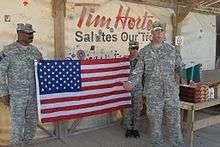
Tim Hortons has outlets located on at least seven Canadian Forces Bases.[174] TDL Group announced in March 2006, in response to a request by Chief of the Defence Staff, General Rick Hillier, its commitment to open a franchised location at the Canadian Forces operations base in Kandahar, Afghanistan. The new Kandahar location opened on July 1, 2006, in a 40-foot (12 m) trailer on the military base.[175] The 41 staff members of the Kandahar outlet have been drawn from the Canadian Forces Personnel Support Agency who received training on such matters as how to handle a potential nuclear or biological attack before working at the military base.[176] The Canadian Federal government subsidized the operation of the Kandahar outlet in the order of CAD$4–5 million per year.[177] The Kandahar Tim Hortons closed on November 29, 2011, after serving four million cups of coffee and three million doughnuts over five years.[178]
The first Tim Hortons outlet at a US military base was opened in 2009 at Fort Knox.[179] The following year, a second Tim Hortons outlet was opened at Naval Station Norfolk.[180] As of November 2011, Tim Hortons has five outlets open on four US military bases. Besides the first two, they are also at Naval Air Station Oceana, and two locations at the Aberdeen Proving Ground.[181]
Roll Up the Rim to Win campaign
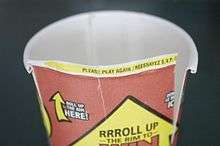
Each February, Tim Hortons holds a marketing campaign called Roll Up the Rim to Win. As of 2007, over 31 million prizes were distributed each year,[182] including cars, televisions, and store products. Customers determine if they have won prizes by unrolling the rim on their paper cups when they have finished their drink, revealing the result underneath. Prizes are not distributed randomly country-wide; each of the company's distribution regions has distinct prize-winning odds.[183] The idea for the campaign began in 1985 when Roger Wilson of one of Tim Hortons' supplier of cups, Lily Cup company, approached Tim Hortons with a new idea to increase their sales. Wilson explained his company had created a new cup design that allowed a message to be printed under the rim; the cup type cost no more than the current one and could enable a promotion or contest.[184] Recognizing the opportunity to promote coffee in the normally weak sales period in the spring, the Roll Up the Rim to Win campaign was first held in 1986 when the biggest prize was a snack box of Timbits.[185] In 2008, over 88% of major prizes were redeemed.[186]
The contest is popular enough that Paul Kind has invented the Rimroller (as seen on Dragons' Den), a device for rolling up the rim mechanically.[187]
In honour of Canada's sesquicentennial, a special edition of the Roll Up the Rim promotion was held in July 2017, with prizes including an "Ultimate Canadian Vacation" valued at $10,000.[188]
The contest has seen several controversies including the theft of unrolled cups.[189] In March 2006, two families were fighting over a Toyota RAV4 SUV prize of C$32,000 value when their daughters found a winning "roll up the rim" coffee cup in a garbage bin of an elementary school in Saint-Jérôme, a town north of Montreal. The younger girl had found a cup in the garbage bin and could not roll up the rim, so she requested the help of an older girl. Once the winning cup was revealed, the older girl's family stated that they deserved the prize. Tim Hortons originally stated that they would not intervene in the dispute. A further complication arose when Quebec lawyer Claude Archambault requested a DNA test be done on the cup. He claimed that his unnamed client had thrown out the cup and was the rightful recipient of the prize.[190] On April 19, 2006, Tim Hortons announced that they had decided to award the prize to the younger girl who had initially found the cup.[191] The company has also faced concerns over the amount of additional litter generated by the promotion.[192]
In 2018, Tim Hortons began to add digital components to the promotion, via the "Scroll Up the Rim" feature (which gave players a chance at food prizes) on the chain's mobile app.[193] In 2020, as part of environmental initiatives and to promote the chain's new Tims Rewards program, Tim Hortons announced that it would only distribute Roll Up the Rim cups during the first two weeks of the campaign. Each eligible purchase by a Tim Rewards member during the first half of the promotion earns two electronic entries, and one electronic entry in the second two weeks. Any purchase using a reusable cup was to award 3 entries.[194][195] On March 7, 2020, due to the COVID-19 novel coronavirus outbreak, Tim Hortons announced that it had cancelled the distribution of physical cups for the promotion (shifting it exclusively to the Tims Rewards app) due to concerns that the virus could be spread by returned cups. The chain had also joined others in temporarily banning the use of reusable cups under similar justification.[196]
Community involvement

Tim Hortons sponsor community outreach programs including Free Skating, Free Swimming, Earn-a-Bike Program, Remembrance Day, Food Drives, the Smile Cookie program, Enactus, as well as a community clean-up project.[197]
The store promotes itself through the "Tim Horton Children's Foundation." Founded by Ron Joyce, the Foundation sponsors thousands of underprivileged children from Canada and the United States to go to one of six high-class summer camps located in Parry Sound, ON; Tatamagouche, NS; Kananaskis, AB; Quyon, QC; Campbellsville, KY; St. George, ON and most recently, Whiteshell, MB.[198][199]
The foundation's highest-profile fundraiser is Camp Day, which is held annually on the Wednesday of the first full week in June. All proceeds from coffee sales at most Tim Hortons locations, as well as proceeds from related activities held that day, are donated to the foundation. Small stores located in Esso Service Stations do not donate coffee proceeds on Camp Day.[200]
Joyce's work with the Tim Horton Children's Foundation earned him the Gary Wright Humanitarian Award in 1991, presented periodically in recognition of contributions to the betterment of community life throughout Canada.[201] In recognition primarily for his work with the Foundation, he received an appointment to the Order of Canada, with the official presentation taking place on October 21, 1992, in Ottawa.[201]

Tim Hortons became a sponsor of Hockey Canada in December 2019, including the presenting sponsor of the Centennial Cup, the national junior "A" ice hockey championship and one of the major sponsors of Canada's national ice hockey teams.[202]
Controversies
Great White North Franchisee Association
The Great White North Franchisee Association, which was formed in 2017, represented Tim Hortons franchises involved in a series of ongoing disputes with the head office of Tim Hortons due to frustrations with Restaurant Brands International (the parent company of Tim Hortons and Burger King). GWNFA has filed class-action lawsuits against the Restaurant Brands International over the handling of the Ontario minimum wage hike (see above), inflated head office pricing, and misuse of their advertising funds.[203]
Ontario minimum wage
Tim Hortons became the subject of controversy after the raise of minimum wage in Ontario from $11.60 to $14.00 an hour which was made effective January 2018. The minimum wage increase was strongly criticized by the Ontario Chamber of Commerce, Restaurants Canada, and the Canadian Franchise Association. Restaurant Brands International did not help franchisees offset the wage hike, refusing to reduce the supply costs that it charged Tim Hortons franchisees, nor did it permit franchisees to raise menu prices in order to offset the wage hikes (in contrast to McDonald's, Cara Foods and Starbucks who did allow menu price increases in Ontario to cope with the wage increases).[203] Tim Hortons franchisees, many of them small business owners who employed an average of 35 staff (the wage hike would cost the franchisee $7,000 per employee a year), responded by cutting employee benefits such as paid breaks and contributions to health plans.[204] In one case, owners posted a memo encouraging employees to contact the Ontario Premier, Kathleen Wynne, and indicate that they "will not vote Liberal in the coming Ontario election in June 2018."[205] Wynne responded by saying "I'm happy to talk to any business owner about the minimum wage but taking it out on employees is not fair and not acceptable."[206] Around 50 demonstrations were held across Canada, including 38 in Ontario, in response to the benefit cuts.[207] The minimum wage controversy hurt the chain's reputation; usually placing in the top 10 of the Leger research poll for the top 10 companies or brands in Canada, Tim Hortons dropped from 4th place in 2017 to 50th in 2018.[208]
Plastics pollutant
Named as one of the top five plastic polluters in Canada in 2018 and 2019; in 2019, Tim Hortons' accounted for "about 11%" of branded plastic waste uncovered by Greenpeace Canada.[209]
In late 2018 and early 2019, Tim Hortons was subject to controversy over their usage of plastic cups. An online Change.org petition asking the company to switch from plastic cups to "a fully recyclable and compostable alternative" gained over 171,000 signatures. The cups are currently not compostable, due to their plastic lining, and are often very difficult to recycle. Tim Hortons has yet to respond to the petition's requests.[210] In early 2020, they gave away reusable cups for their "Roll Up the Rim to Win" promotion, to eliminate single-use plastic in their establishments. The effort was criticized as greenwashing through a limited-time promotion.[211]
Sick-leave during coronavirus pandemic, 2020
In March 2020, Tim Hortons met criticism for not offering sick-leave concessions to employees during the COVID-19 pandemic in Canada.[212][213]
See also
References
- "Tim Hortons Inc. – Company Overview". Hoover's.
- http://www.rbi.com/Cache/396848915.PDF?O=PDF&T=&Y=&D=&FID=396848915&iid=4591210
- http://www.rbi.com/file/4591210/Index?KeyFile=1500096187
- http://www.cbc.ca/news/business/tim-hortons-minimum-wage-worker-benefits-1.4480097
- "News Release Details | Corporate". Tim Hortons.
- "Corporate Profile". Tim Hortons. Retrieved March 8, 2015.
- "Archived copy". Archived from the original on November 18, 2015. Retrieved November 14, 2014.CS1 maint: archived copy as title (link) The Story of Tim Hortons
- "Tim Hortons to add 500 Canadian outlets, 300 in U.S. by 2018". The Globe and Mail. February 25, 2014. Archived from the original on February 25, 2014. Retrieved February 25, 2014.
- "The Story of Tim Hortons". Tim Hortons. Archived from the original on May 30, 2008. Retrieved July 12, 2008.
- Gallagher, Danny (August 13, 2009). "The 'idea guy' behind Tim Hortons saw others get rich while he went bankrupt: Entrepreneur was the ill-fated hockey player's first partner in the little doughnut chain that grew". The Globe and Mail. Canada. Retrieved December 16, 2010.
- Austen, Michael J. de la Merced and Ian. "Global Web of Financial Connections in Burger King's Deal for Tim Hortons".
- "3G Capital - Restaurant Brands International". www.3g-capital.com.
- Cormack, Patricia, "True Stories' of Canada Tim Hortons and the Branding of National Identity," Cultural Sociology 2, no. 3 (2008): 371
- "Tim Horton (1930–1974)". Tim Hortons. Archived from the original on February 29, 2008. Retrieved November 25, 2008.
- "The Story of Tim Hortons". Tim Hortons. Archived from the original on May 30, 2008. Retrieved November 25, 2008.
- "The unofficial national sugary snack". My Canada Includes Tourtière. September 1, 1994. Canadian Broadcasting Corporation.
- Saltzman, Aaron (January 5, 2018). "Multiple Tim Hortons franchises, other businesses cut pay, benefits, citing minimum wage hike". CBC News. Retrieved August 27, 2019.
- Dickinson, Casey (November 24, 2000). "Canadian Doughnut Shop Targets Upstate". CNY Business Journal.
- "French language Commerce laws" (PDF). oqlf. Retrieved January 29, 2020.
- "To apostrophe or not apostrophe? Why is Tim Hortons not Tim Horton's?". WKYC. Retrieved March 6, 2019.
- "QuebeCitie: Tim Hortons: Bilingual signage? Or not". April 15, 2019.
- US burger giant buys Tim Hortons doughnut chain. Canadian Broadcasting Corporation. August 10, 1995.
- Susan Kastner Simple fairytale takes on whole new meaning Archived October 23, 2012, at the Wayback Machine [Final Edition] August 13, 1995, page E.2 Section: PEOPLE Toronto Star
- "Wendy's confirms Tim Hortons IPO by March". Ottawa Business Journal. December 1, 2005. Archived from the original on June 29, 2006.
- Harris, Rebecca (February 7, 2005). "Marketer of the Year: Down-Home Smarts". Marketing Magazine. Archived from the original on September 27, 2007.
- "Wendy's Says Nelson Peltz Gave 'Ultimatum'". Fox News Channel. Reuters. December 30, 2005. Retrieved March 1, 2015.
- "Wendy's to spin off all of Tim Hortons by end of 2006". CBC News. March 3, 2006.
- "Wendy's International, Inc. Announces Comprehensive Strategic Initiatives to Enhance Shareholder Value" (Press release). Tim Hortons. July 29, 2005.
- "TheStar.com – Page Not Found". September 29, 2007. Archived from the original on September 29, 2007.
- "TheStar.com – Tim Hortons joins S&P/TSX index roster". November 11, 2006. Archived from the original on November 11, 2006.
- Fineman, Josh; Scanlan, David (March 23, 2006). "Tim Hortons Raises C$783 Million in Initial Offering". Bloomberg. Archived from the original on September 30, 2007.
- "Registration statement filed for proposed reorganization of Tim Hortons as a Canadian public company" (Press release). Tim Hortons. June 29, 2009. Archived from the original on August 12, 2009.
- Friend, David (June 30, 2009). "Tim Hortons returns officially to Canada". Toronto Star.
- "Tim Hortons Inc. completes public company merger and reorganization" (Press release). Tim Hortons. CNW Group. September 28, 2009. Retrieved September 29, 2009.
- Campion-Smith, Bruce (September 24, 2009). "Doughnuts over diplomacy". The Star. Toronto.
- "Tim Hortons now offers Interac debit system across Canada" (Press release). Tim Hortons. CNW Group. November 23, 2010. Retrieved November 26, 2010.
- "Tim Hortons to introduce MasterCard payment in Canada". Tim Hortons. June 29, 2007. Retrieved December 13, 2010.
- "Now Serving...VISA at Tim Hortons". Tim Hortons. May 15, 2012. Retrieved August 24, 2017.
- "Ordering Your Morning Double-Double Just Got More Rewarding: American Express Serves up New Relationship with Tim Hortons". Tim Hortons. July 8, 2013. Retrieved August 24, 2017.
- "Archived copy". Archived from the original on December 19, 2014. Retrieved July 26, 2016.CS1 maint: archived copy as title (link)
- "Burger King in talks to acquire Tim Hortons". The Globe and Mail. Retrieved August 25, 2014.
- "Burger King in Talks to Buy Tim Hortons in Canada Tax Deal". The Wall Street Journal. Retrieved August 25, 2014.
- "Tim Hortons, Burger King agree to merger deal". CBC News. August 26, 2014. Retrieved August 26, 2014.
- De La Merced, Michael (August 26, 2014). "Burger King to Buy Tim Hortons for $11.4 Billion". The New York Times. United States. Retrieved August 26, 2014.
- Sturgeon, Jamie. "Ottawa gives Burger King go-ahead for Tim Hortons takeover". globalnews.ca. Global News. Retrieved December 23, 2014.
- "Tim Hortons, Burger King deal OK'd by Competition Bureau". CBC News. Retrieved December 10, 2014.
- "Burger King, Tim Hortons ink merger deal for $12.5-billion". The Globe and Mail. Retrieved August 26, 2014.
- CBC Radio – Metro Morning (October 30, 2014). "Bad For Canada?". CBC Radio – Metro Morning. Retrieved November 9, 2014.
- Friend, David (October 30, 2014). "Tim Hortons-Burger King Deal Could Lead To Layoffs, Cost Cutting: Analysis". The Canadian Press, Huffington Post. Retrieved November 9, 2014.
- Luckhardt, Natasha (October 30, 2014). "Trouble Brewing: Why the Tim Hortons Takeover is a Bad Deal for Canadians". Canadian Centre for Policy Alternatives.
- "Burger King promises to ramp up Tim Hortons' U.S. expansion as Ottawa approves takeover". Financial Post. Retrieved December 10, 2014.
- "Tim Hortons enters 'next chapter' as shareholders approve Burger King's $12.5 billion takeover". Financial Post. Retrieved December 10, 2014.
- "Tim Hortons, Burger King finalize merger to form Restaurant Brands International". The Canadian Press. Archived from the original on December 16, 2014. Retrieved December 13, 2014.
- Sturgeon, Jamie. "Burger King gets go-ahead to gobble up Tim Hortons". globalnews.ca. Global News. Retrieved December 23, 2014.
- Everson, Kristen (December 6, 2014). "Tim Hortons takeover conditions demanded by public, James Moore says". CBC News.
- "Archived copy". Archived from the original on August 25, 2016. Retrieved September 20, 2016.CS1 maint: archived copy as title (link)
- "Archived copy". Archived from the original on September 23, 2016. Retrieved September 20, 2016.CS1 maint: archived copy as title (link)
- "2015 Annual Report" (PDF). Restaurant Brands International. Retrieved December 31, 2015.
- "Tim Hortons owner sees big jump in profit in 2016, revenue edges up". February 13, 2017.
- "Tim Hortons owner eyes rapid expansion in U.S. despite uncertainty around Trump | The Star". thestar.com.
- Kalinowski, Tess (April 17, 2018). "Tim Hortons to move its Canadian head office". The Star. Toronto Star Newspapers Ltd. Retrieved April 17, 2018.
- "Tim Hortons falls from 13th to 67th in ranking of Canada's most reputable companies". The Star. Toronto Star Newspapers Ltd. Retrieved March 30, 2019.
- "Tim Hortons sales grow in Canada as franchisee relationship on the mend | CTV News Toronto". toronto.ctvnews.ca. Retrieved March 13, 2019.
- "Tim Hortons - Statistics & Facts". Statista.com. Retrieved January 9, 2017.
- "Corporate Profile". Tim Hortons. Retrieved June 15, 2013.
- timhortons.co.uk
- "Wal-Mart Canada supercenters to have Tim Hortons". Reuters. September 13, 2007.
- "Tim Hortons brings a taste of home to troops in Kandahar" (Press release). Tim Hortons. 2006. Retrieved November 21, 2007.
- O'Connor, Elaine (April 12, 2006). "Tim Hortons hiring for Afghanistan". The Province. Archived from the original on November 27, 2013. Retrieved November 21, 2007.
- "All Tim Hortons Locations in Aberdeen Proving Ground | Coffee, Breakfast, Specialty Beverages". locations.timhortons.com.
- "Tim Hortons strikes gold at Fort Knox" (Press release). Tim Hortons. October 13, 2009. Retrieved November 28, 2009.
- "Tim Hortons opens on Naval Station Norfolk" (Press release). Dublin, Ohio: Tim Hortons. January 21, 2010. Archived from the original on October 23, 2013. Retrieved January 22, 2010.
- "FAQS". Tim Hortons.
- "Tim Hortons lands in Iqaluit". CBC News. December 3, 2010.
- "Tim Hortons stock jumps in trading debut". CTV.ca. March 24, 2006.
- "All Tim Hortons Locations in Fredonia | Coffee, Breakfast, Specialty Beverages". locations.timhortons.com.
- "Tim Hortons in 101 Broad St Plattsburgh, NY | Coffee, Breakfast, Specialty Beverages". locations.timhortons.com.
- "22 Things That All UBC And SFU Students Have In Common". www.narcity.com.
- "More than a Great Brand. Tim Hortons outlines strategic growth catalysts and financial outlook at investor conference" (Press release). Tim Hortons. March 5, 2010. Archived from the original on August 12, 2009.
- Mathieu, Emily (March 6, 2010). "Tim Hortons to boost outlets, test drive upscale U.S. format". Toronto Star. Retrieved March 6, 2010.
- "Canadian Press, via Winnipeg Free Press: "North West Co. to open three Tim Hortons kiosks in Iqaluit, Nunavut", 27 October 2010".
- "Company Facts". Tim Hortons. August 16, 2013.
- Mullins, Paul R. (2008). Glazed America: a history of the doughnut. p. 115. ISBN 9780813032382.
- "Timeline | Corporate". Tim Hortons.
- "Wendy's buys 37 Rax units, plans Tim Hortons makeover". Nation's Restaurant News. November 4, 1996. Retrieved December 8, 2009.
- "Tim Hortons keeps expanding in WNY". Buffalo Business First. January 21, 2011.
- "Tim Hortons to Add 82 U.S. Locations in Grocery Stores". Foodservice and Hospitality. October 14, 2008.
- Nelson, Libby (July 13, 2009). "The Doughnut Wars Begin". City Room.
- Mukhopadhyay, Bhaswati (November 11, 2010). "Tim Hortons profit climbs; to close 36 US stores". Reuters. Retrieved November 16, 2010.
- "Tim Hortons makes its way to town". TribLIVE. September 16, 2010. Retrieved March 3, 2013.
- Cammel, Ron (October 12, 2011). "Tim Hortons coffee, doughnut shop prepares to open several more West Michigan locations". mlive. Archived from the original on June 19, 2014.
- "Youngstown News, Tim Hortons looks to expand in Valley". Vindy.com. June 26, 2012. Retrieved March 3, 2013.
- "Tim Hortons announces several Mahoning Valley locations". WFMJ-TV. February 18, 2019. Retrieved August 27, 2019.
- https://www.wfmj.com/story/41403378/tim-hortons-closes-in-girard
- "Archived copy". Archived from the original on August 26, 2016. Retrieved April 20, 2014.CS1 maint: archived copy as title (link)
- "Archived copy". Archived from the original on August 25, 2016. Retrieved April 20, 2014.CS1 maint: archived copy as title (link)
- "Archived copy". Archived from the original on October 30, 2014. Retrieved April 20, 2014.CS1 maint: archived copy as title (link)
- "Tim Hortons – The Flagship Store Opens". Buffalo Rising. October 29, 2014.
- Ewoldt, John. "Tim Hortons now open at Mall of America". Star Tribune. Retrieved September 29, 2017.
- Petkovic, John. "Tim Hortons donut chain to move into Northeast Ohio with 105 stores (photos)". Cleveland.com. Retrieved June 16, 2019.
- "Tim Hortons sets July date for Ellet store opening". Akron Beacon Journal. June 27, 2019. Retrieved August 27, 2019.
- "Trying Out The First Ever Tim Hortons in The Philippines". Ondagoo.
- "Tim Hortons sees Philippines as 'natural gateway' to Asian expansion". Toronto Star. Retrieved March 27, 2017.
- "First Tim Hortons in PH: Photos, price points, what to expect". Rappler. Retrieved March 27, 2017.
- "Tim Hortons Philippines Locations". Tim Hortons. Archived from the original on July 6, 2017. Retrieved March 27, 2017.
- Stone, Laura (September 20, 2011). "Tim Hortons' double-double comes to Dubai". Toronto Star. Retrieved September 20, 2011.
- "Canada's Tim Hortons signs deal for 120 Gulf outlets". Arabian Business (Press release). February 6, 2011. Retrieved February 6, 2011.
- 2 March 2013 8:56 PM EST Facebook Twitter RSS (November 12, 2012). "Tim Hortons opens in Oman". Toronto Star. Retrieved March 3, 2013.
- "Tim Hortons Branches in Kuwait". Rinnoo (Press release). June 25, 2019. Retrieved June 25, 2019.
- "Tim Hortons to Launch in China". Tim Hortons.
- "Tim Hortons to Launch in Thailand". Tim Hortons.
- "SPAR launches new Food Strategy as part of €90m expansion plan for 2006" (Press release). SPAR. January 2006.
- "Presentation by Dermot Breen, Tesco Ireland, at Checkout Conference "The importance of the consumer"" (Press release). Tesco Ireland. January 24, 2006. Retrieved November 7, 2006.
- "SPAR Ireland Continues to Expand Tim Hortons Kiosks in SPAR Convenience Store Locations in Ireland" (Press release). Tim Hortons. April 30, 2007. Retrieved December 3, 2009.
- "Find A Location Near You | Tim Hortons UK". timhortons.co.uk.
- "Spaniards line up for opening of first Tim Hortons in Madrid | Dished". dailyhive.com.
- "Company Facts". Tim Hortons. Archived from the original on September 9, 2009.
- "Wendy's International, Inc. and IAWS Group, plc announce strategic alliance" (Press release). Tim Hortons. March 6, 2001.
- "Nutrition guide" (PDF). Tim Hortons. Archived from the original (PDF) on February 5, 2009.
- Flavelle, Dana (September 27, 2006). "Tim's heats up menu wars". Toronto Star. Archived from the original on September 29, 2007. Retrieved September 29, 2006.
- Flavelle, Dana (April 21, 2009). "McDonald's offers free java in coffee wars". Toronto Star. Retrieved April 21, 2009.
- "Archived copy". Archived from the original on May 8, 2016. Retrieved March 17, 2015.CS1 maint: archived copy as title (link)
- "Coffee is the newest battleground for fast food giants". Daily Brew.
- Tim Hortons. "Canada, get ready for the freeze. Tim Hortons launches new Frozen Lemonade". Timhortons.com. Retrieved March 3, 2013.
- Jaime Myslik (August 14, 2014). "Tim Hortons targets Starbucks crowd with new dark roast coffee". The Globe and Mail.
- Tim Hortons. "Tim Hortons: On Our Menu". Retrieved November 20, 2009.
- "The first 50-years: A brief history of Tim Hortons | Inside Timmies". Retrieved March 6, 2019.
- Heffner, Jessica (February 9, 2009). "Tim Hortons, Cold Stone announce co-branding deal". The Oxford Press. Archived from the original on February 14, 2009.
- Hilmantel, Robin (February 9, 2009). "Tim Hortons and Cold Stone will team up in 100 stores". QSR magazine. Archived from the original on February 14, 2009.
- Dentch, Courtney (February 6, 2009). "Tim Hortons, Cold Stone to form 100 co-branded stores". Bloomberg. Archived from the original on June 3, 2010.
- Baertlein, Lisa (February 6, 2009). "Tim Hortons, Cold Stone to wed doughnuts, ice cream". Reuters.
- City News Toronto Dutchie Timbit among 24 items cut from Tim Hortons menu Archived April 22, 2016, at the Wayback Machine February 21, 2014
- https://recipes.howstuffworks.com/poutine-canada.htm
- https://jumpradio.ca/news/4276306/you-can-now-order-a-poutine-at-tim-hortons-locations-across-canada/
- https://dailyhive.com/vancouver/internet-ripping-tim-hortons-poutine
- "Our brands: Tim Hortons". Wendy's International. Archived from the original on January 15, 2008.
- Swick, David (September 17, 2003). "Going from fresh to frozen". Halifax Daily News. Archived from the original on September 8, 2012.
- "Tim Hortons sued by franchisees over frozen doughnuts". Financial Post. June 13, 2008. Archived from the original on October 20, 2013. Retrieved July 21, 2013.
- Dobby, Christine (August 16, 2011). "Tim Hortons par-baking cut into profits: lawsuit". Calgary Herald/Financial Post. Archived from the original on September 29, 2013. Retrieved July 21, 2013.
- Friscolanti, Michael (September 6, 2011). "Tim Hortons: rolling in dough". Maclean's. Retrieved July 21, 2013.
- Brean, Joseph (February 28, 2012). "Tim Hortons franchisees lose $2-billion doughnut lawsuit". National Post. Retrieved July 21, 2013.
- Ron Lieber Tim Hortons Arrives in Bits and Pieces Archived December 15, 2014, at the Wayback Machine July 14, 2009, New York Times
- Fineman, Josh; Scanlan, David (March 23, 2006). "Tim Hortons Raises C$783 Million in Initial Offering". Bloomberg. Archived from the original on June 26, 2009.
- "Investing in an icon: Why everyone wants a piece of Tim Hortons". Ottawa Citizen. March 19, 2006. Archived from the original on April 7, 2011.
- Kidd, Keneth (March 26, 2006). "Timbit Nation". Toronto Star. Archived from the original on June 14, 2006.
- "Troops in Kandahar to get a Tim Hortons shop". CTV.ca. March 7, 2006.
- "Season of Champions Sponsors". Canadian Curling Association. Archived from the original on January 14, 2010. Retrieved January 18, 2010.
- "Quickpay Tim Card". Tim Hortons. Retrieved February 1, 2010.
- "Tim Hortons relents, workers join 'Red Friday'". CTV News. September 29, 2006.
- "Tim Hortons USA". Twitter.
- "Tim Hortons". Facebook.
- Robson, Dan (August 11, 2009). "Tim Hortons withdraws donation to anti-gay event". Toronto Star.
- "Tim Hortons responds to inquiries about Rhode Island event sponsorship". Tim Hortons. Archived from the original on September 13, 2012.
- "Tim Hortons backs out of anti-gay marriage event". CBC News. August 10, 2009.
- "Goodbye Ivor Wynne, hello Tim Hortons Field". TheSpec.com. July 12, 2013. Retrieved July 14, 2013.
- "Brian Jean, Wildrose leader, boycotts Tim Hortons after Enbridge ads pulled". CBC News. Retrieved June 5, 2015.
- "Tim Hortons Stops Running Enbridge's Ads Following Public Backlash". Vice News. Retrieved June 5, 2015.
- "Tim Hortons yanks Enbridge ads, sparks Alberta backlash". CBC News. Retrieved June 5, 2015.
- Levant, Ezra (June 9, 2015). ""Don't lie to me": Ezra Levant confronts Tim Hortons president over #BoycottTims". TheRebel. Retrieved June 9, 2015.
- "Archived copy". Archived from the original on March 4, 2016. Retrieved November 23, 2015.CS1 maint: archived copy as title (link)
- "Archived copy". Archived from the original on March 3, 2008. Retrieved April 14, 2006.CS1 maint: archived copy as title (link)
- "Archived copy". Archived from the original on August 26, 2014. Retrieved March 6, 2009.CS1 maint: archived copy as title (link)
- "Tracing the roots of a Canadian icon". The Gazette. March 21, 2006. Archived from the original on March 13, 2007.
- Grant, Tavia (March 24, 2006). "Tims holds gains". The Globe and Mail. Canada. Archived from the original on March 21, 2007.
- "Bay Street Week Ahead-Tim Hortons serves up hot IPO to go". Reuters News. March 26, 2006. Archived from the original on April 28, 2006.
- "But can iconic coffee chain sustain growth, analysts wonder". Winnipeg Free Press. March 20, 2006.
- Griffiths, Rudyard (August 15, 2006). "Timbit Nation?". Winnipeg Free Press.
- "How Tim Hortons won the Internet with The Priestley | canada.com". O.canada.com. Retrieved March 3, 2013.
- "Tim Hortons, Cold Stone to create new stores". Toronto Star. Associated Press. February 6, 2009.
- "Tim Hortons to co-brand six stores in Ontario with Cold Stone Creamery". Amherest Daily News. The Canadian Press. June 11, 2009. Archived from the original on June 15, 2009. Retrieved September 15, 2009.
- David Friend, David (February 20, 2014). "Tim Hortons to co-brand six stores in Ontario with Cold Stone Creamery". CTV News. The Canadian Press. Retrieved July 11, 2014.
- "Tim Hortons strikes gold at Fort Knox". Tim Hortons Press Release. October 13, 2009.
- "Tim Hortons comes to Kandahar". CBC News. June 12, 2006.
- "Hopefuls for Tim Hortons Kandahar outlet get survival training". CBC News. May 5, 2006.
- "Ottawa foots bill for Afghan Tim Hortons: Canadian taxpayer foots nearly $4-million bill". Canada.com. 2006. Archived from the original on April 7, 2011.
- "Tim Hortons closes up shop in Kandahar". National Post. Canada. November 24, 2011.
- "Tims breaks into Fort Knox". The Globe and Mail. Canada. October 13, 2009.
- "Tim Hortons opens on Naval Station Norfolk". Tim Hortons Press Release. January 21, 2010.
- "Tim Hortons Cafe & Bake Shop Honors All U.S. Veterans With Free Donut". Tim Hortons Press Release. November 3, 2011.
- "Rrroll Up The Rim To Win Is Back at Tim Hortons!" (Press release). Tim Hortons. February 26, 2007. Retrieved March 10, 2007.
- "Not all rims rrroll up equally". Canadian Broadcasting Corporation. March 15, 2006.
- O'Reilly, Terry (February 16, 2017). "Small Move, Big Gain: An Encore Presentation". CBC Radio One. Pirate Radio. Retrieved February 18, 2017.
- "Tim Hortons Roll Up The Rim 2012: 5 facts you should know about this iconic promotion". HuffPost. August 17, 2013.
- "RRRoll Up Fun: Fun Facts". RRRoll up the rim to win!. Archived from the original on March 12, 2009.
- "Finally! A Rimroller!!". Winnipeg Free Press. March 11, 2007.
- Dunham, Jackie (June 28, 2017). "'Roll Up The Rim' returns: Tim Hortons contest back for Canada 150". CTVNews. Retrieved March 8, 2020.
- "A history of Tim Hortons' Roll Up the Rim-related controversy". ca.news.yahoo.com.
- "Lawyer wants DNA test on 'Roll up the Rim' cup". Canadian Broadcasting Corporation. March 10, 2006. Archived from the original on February 16, 2007.
- "Finders, keepers: Tim Hortons puts a lid on cup contest controversy". CBC News. April 19, 2006.
- "Tim Hortons urged to green up its roll up the rim contest". CBC News. Retrieved March 26, 2019.
- "With Scroll Up To Win, Tim Hortons re-imagines Roll Up The Rim for the mobile age". MobileSyrup. February 7, 2018. Retrieved February 7, 2018.
- "Tim Hortons moves toward a digital Roll Up the Rim contest". Toronto Star. February 18, 2020. Retrieved March 8, 2020.
- Rodriguez, Jeremiah (February 19, 2020). "How does the new Tim Hortons' 'Roll Up The Rim' contest work?". CTV News. Retrieved March 8, 2020.
- "Tim Hortons gets rid of Roll Up The Rim paper cups amid coronavirus outbreak". Toronto Star. March 7, 2020. Retrieved March 8, 2020.
- "Local Programs". Tim Hortons. Archived from the original on September 30, 2009. Retrieved December 8, 2009.
- "Children's Foundation". Tim Hortons. Archived from the original on December 16, 2009. Retrieved December 8, 2009.
- "Childrens Foundation Camps". Tim Hortons Childrens Foundation. Retrieved October 4, 2016.
- "Camp Day". Tim Hortons. Archived from the original on March 29, 2009. Retrieved December 8, 2009.
- "We Care Awards". Friends of We Care. Retrieved December 8, 2009.
- "Hockey Canada announce expanded marketing partnership". Hockey Canada. December 12, 2019.
- "'We are offended': Franchisees blast Ontario premier for unfairly targeting Tim Hortons' founding families | Financial Post". January 5, 2018.
- Sagan, Aleksandra (January 4, 2018). "Children of Tim Hortons co-founders cut worker benefits at their franchises over wage hike". The Globe and Mail. Retrieved January 23, 2018.
- Harris, Sophia (January 19, 2018). "Tim Hortons franchise owners tell workers to blame Wynne for benefit cuts and to 'not vote Liberal'". CBC News. Retrieved January 23, 2018.
- Jeffords, Shawn (January 19, 2018). "Wynne criticizes Tim Hortons franchisees, says workers shouldn't be pawns". The Globe and Mail. Retrieved January 23, 2018.
- Hodges, David (January 18, 2018). "Tim Hortons protests to expand beyond Ontario, 50 demonstrations planned across Canada". Toronto Star. Retrieved January 23, 2018.
- "Tim Hortons slides from fourth to 50th in brand reputation survey". Retrieved April 6, 2018.
- "These companies are the top 5 plastic polluters in Canada". Daily Hive. October 10, 2019. Retrieved March 12, 2020.
- News (February 4, 2019). "Trio of Calgary kids ask Canadian coffee chain to rethink popular contest | National Post". Retrieved March 31, 2019.
- "Opinion: Tim Hortons's half-baked Roll Up The Rim changes are just another example of corporate greenwashing". Retrieved March 12, 2020.
- Leavitt, Kieran (March 25, 2020). "'I expect you to show up': Tim Hortons calls sick-leave note spotted in Alberta restaurant 'unfortunate'". Toronto.com. Retrieved March 28, 2020.
- Mojtehedzadeh, Sara (March 14, 2020). "Tim Hortons responds to backlash over sick-leave policy amid COVID-19 outbreak". The Star. Retrieved March 28, 2020.